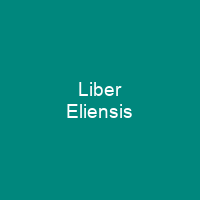The Liber Eliensis: A 12th-Century Chronicle of Ely Abbey
Imagine stepping back in time to the 12th century, where a group of monks meticulously recorded the history of their abbey and the surrounding lands. This is precisely what the Liber Eliensis does—chronicling the founding, growth, and struggles of Ely Abbey from its early days up until the middle of the 12th century.
The Birth of a Chronicle
Was it Richard or Thomas who penned this monumental work? Historians debate the authorship, but one thing is certain: the Liber Eliensis was written at Ely Abbey, which became a cathedral in 1109. The chronicle covers an extensive period from 673 to the middle of the 12th century, making it a valuable resource for understanding the history of this region.
A Composite History
The work is not just one man’s account; it’s a compilation of various sources. The Liber Eliensis draws from earlier works like Bede’s Ecclesiastical History of the English People and William of Poitiers’ Gesta Guillelmi II ducis Normannorum. It’s a mosaic of history, pieced together with documents and charters that provide insight into the lives of bishops and abbesses.
The Chronicles of Ely Abbey
From the founding of Ely Abbey to its restoration under Bishop Æthelwold, the chronicle covers it all. It details subsequent abbots, charters, and documents that paint a vivid picture of life in 12th-century England. The final book discusses the conversion of the abbey into a bishopric and even includes an account of Thomas Becket’s martyrdom.
Historical Significance
The Liber Eliensis has been used as a source by modern historians like Richard Huscroft and Thomas Peacocke. They analyzed its contents, providing us with a deeper understanding of the period. The chronicler describes the devastating effects of famine caused by failed harvests and pillaging, painting a grim picture of life during King Stephen’s reign.
Monastic Miracles and Pilgrimages
The Liber Eliensis is not just about politics and war; it’s also a testament to the miracles attributed to Saint Æthelthryth, Ely’s patroness. The work incorporates an earlier Vita written by Goscelin, which helped increase pilgrimages to Ely. This, in turn, allowed monks to better explain the history of donations to the abbey.
Land and Gifts
The chronicle records gifts to the abbey church, including a notable gift from Queen Emma. It also documents the acquisition of land by the abbey and its possession rights. The Liber Eliensis is a treasure trove for historians, providing insights into the legal and administrative aspects of monastic life.
Conflict and Division
The work highlights conflicts between the abbey and bishops, particularly after the conversion of Ely Abbey into a bishopric. It also records the division of property between monks and bishops, reflecting the complex relationships within the church hierarchy during this period.
A Legacy of Knowledge
Despite its importance, the Liber Eliensis is not without its flaws. The documents are considered unreliable due to their tendentious nature. However, they remain valuable for understanding the history of the time and the internal workings of Ely Abbey. Two complete manuscripts survive, complemented by partial ones, ensuring that this historical treasure endures.
The Royal Historical Society published Liber Eliensis edited by E. O. Blake in 1962, with a Latin text along with some Old English texts but no translation. In 2005, Janet Fairweather produced an English translation of the Latin, published by Boydell & Brewer.
The Liber Eliensis is more than just a historical document; it’s a window into the past, offering us a glimpse of life in medieval England through the eyes of its monks. It serves as a reminder of the importance of preserving our history and understanding the stories that shaped our world.
You want to know more about Liber Eliensis?
This page is based on the article Liber Eliensis published in Wikipedia (retrieved on November 30, 2024) and was automatically summarized using artificial intelligence.







